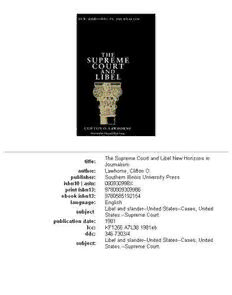
The Supreme Court and libel PDF
01981·0.276 MB·English
Most books are stored in the elastic cloud where traffic is expensive. For this reason, we have a limit on daily download.
Preview The Supreme Court and libel
Description:
The decisions of the United States Supreme Court regarding libel during the past fifty years show a continuous march toward freedom of speech and press despite fluctuations in the Court’s philosophy. Lawhorne, who earlier traced the development of the law in Defamation and Public Officials: The Evolving Law of Libel, now documents how and why the law has changed. He emphasizes the decisions of the Court since 1931, when state libel laws were first curtailed by new interpretations of the Constitution. He provides a brief treatment of the adoption of the First Amendment, the early formulation of the law of libel, and important early decisions of the Court. Lawhorne stresses the law of libel as it is today to provide a ready handbook for students, communicators, and educators. He carefully points out that the current status of the law is not and cannot be final. His detailing of decisions makes clear that the law is not static. This careful demonstration that the law is in a state of constant evaluation and change is among the major assets of this book. Lawhorne suggests that over the years the Court has in effect integrated the First and Fourteenth Amendments. “Congress shall make no law… abridging freedom of speech, or of the press… nor shall any State deprive any person of life, liberty, or property without due process of law.” He demonstrates the way in which the “public-issue” standard was replaced by a secondary constitutional privilege that allowed discussion containing defamatory falsehoods about private individuals, provided those falsehoods were not published negligently. Finally, he examines decisions of the Burger Court that have narrowly interpreted the judicially determined constitutional privileges, giving plaintiffs the benefit of doubt in their efforts to obtain damages for libelous falsehoods. A highly useful exposition of the evolution and present state of libel law in the United States.
See more
The list of books you might like
Most books are stored in the elastic cloud where traffic is expensive. For this reason, we have a limit on daily download.
